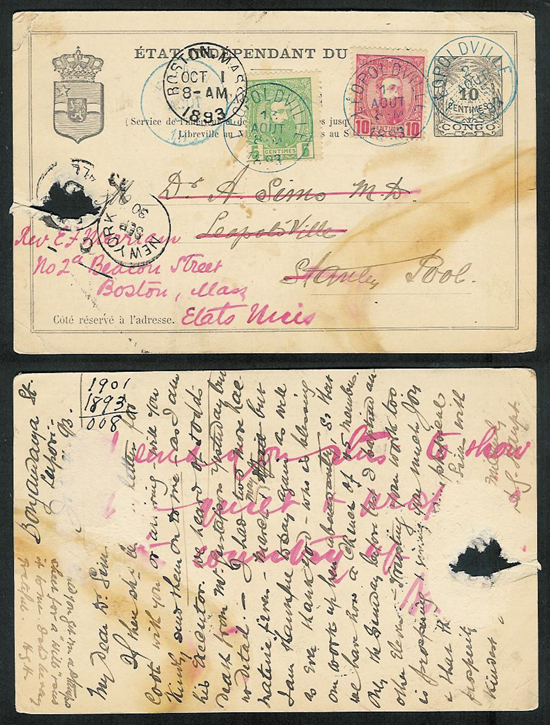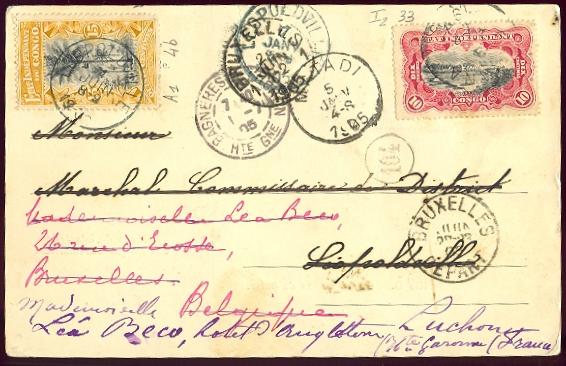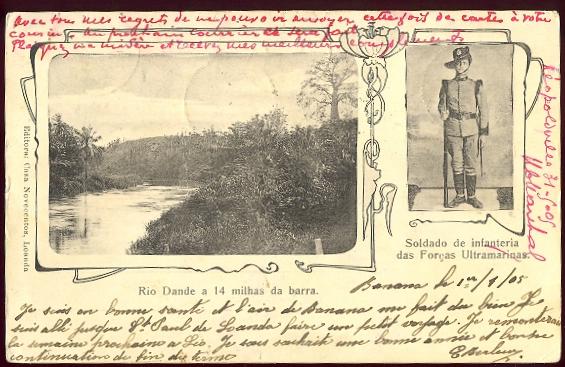Passing the message on by re-use of postcards!
It would not have been uncommon for the European settler or trader living or travelling in the Congo Free State to have been unable to find in every village or town, a post office or a shop in which to buy his picture postcards or postal stationery. Consequently we very occasionally find (but it’s not easy !!) cards already having passed through the postal system being re-used with a new message, to a new addressee and with a new franking.1
Those to which I refer are not examples of mail having been ‘forwarded’, because the addressee has moved on, but a complete re-use of an old card to a totally different person at a totally different address.
Usually to make everything clear, the second sender scratched out or manuscript erased reference to the first addressee and put his new message to the new address in another ink..
In 20 years of collecting, I have seen only 2 items and illustrate them here:
Postal Stationery, 10c. – Stibbe 4a
First use: internally to Dr. Sims, M.D. (Master of Divinity)
Second use:
– Readdressed, re-franked (15 centimes) and posted
to the U.S.A.

The card was written at Bonyamanya, 4th July 1893 and addressed to Leopoldville; there are no transit marks and it was simply cancelled on arrival 2nd August 1893. The ‘10c. Stationery Card’ represents the rate applicable for internal mail.
It was then further franked at 15 centimes for re-use, and addressed to the U.S.A. with an overwritten message. In red ink the first addressee’s name and address were crossed out and a new name and address added.
In its ‘second usage’ the ‘Stationery Card’ was posted in Leopoldville on 13th Aug. 1893 and travelled to Boston, where it arrived 1st October; transits at Boma, 21st August and New York, 30th September 1893.
The 15 centimes franking is the correct one for Postal Stationery to foreign countries; but having been re-franked the card has now lost its Postal Stationery status and is simply a Post Card - with or without
picture. It is worth noting that in 1893 there was no specified postage rate for a POST CARD - other than that as a letter, for which the rate was 50 centimes.
In reality the ‘Postal Authority’ in both Leopoldville and Boma (receiving and transit marks applied) accepted and permitted this card for conveyance without any further Postage Due.
Having left the Congo’s territory the postage rate for a Postcard in the UPU is 15c. and therefore this card completed its travels legitimately.
Angolan Picture Postcard


First use: Internal (10 centimes), Banana to Leopoldville.
Second use: Readdressed, re-franked (15 centimes), posted from the Congo to Belgium, and then forwarded to France.
This item is an Angolan Picture Postcard written in Banana on
1st January 1905.
As was usual at the time, the writer’s message and address have been
written in the brief space provided on the picture side. Black ink was used and
whilst
The postage rate for an internal postcard was 10 centimes, with
which it was correctly franked. It was received by the Banana post office 3rd
January and arrived in
Using red ink a new message has been added, along with the address
of a new recipient. It was re-franked correctly at 15 centimes and posted from
Leopoldville, 1st June 1905 to
It was finally readdressed and forwarded to
N.B. If you see in a dealer’s boxes, postal stationery or postcards with unusual franking or even in inferior condition – don’t forget to check them before moving on. Perhaps you may be lucky enough to find such items!
1. Reading between the lines, so to speak, both items illustrate a convenient way of letting a friend know what another friend had written. Today we would simply photocopy or forward by email. (Editor)